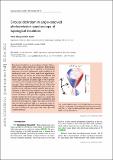Circular dichroism in angle-resolved photoemission spectroscopy of topological insulators
Author(s)
Wang, Yihua; Gedik, Nuh
DownloadGedik_Circular dichroism.pdf (1.707Mb)
OPEN_ACCESS_POLICY
Open Access Policy
Creative Commons Attribution-Noncommercial-Share Alike
Terms of use
Metadata
Show full item recordAbstract
Topological insulators are a new phase of matter that exhibits exotic surface electronic properties. Determining the spin texture of this class of material is of paramount importance for both fundamental understanding of its topological order and future spin-based applications. In this article, we review the recent experimental and theoretical studies on the differential coupling of left-circularly versus right-circularly polarized light to the topological surface states in angle-resolved photoemission spectroscopy. These studies have shown that the polarization of light and the experimental geometry play a veryimportant role in both photocurrent intensity and spin polarization of photoelectrons emitted from the topological surface states. A general photoemission matrix element calculation can quantitatively explain the observations and is also applicable to topologically trivial systems with strong spin–orbit coupling. These experimental and theoretical investigations suggest that optical excitation with circularly polarized light is a promising route towards mapping the spin–orbit texture and manipulating the spin orientation in topological and other spin–orbit coupled materials.
The circular-dichroic angle-resolved photoemission spectrum of Bi2Se3 as obtained by the difference between spectra taken with left-circularly vs. right-circularly polarized light using a time-of-flight electron spectrometer.
Date issued
2013-02Department
Massachusetts Institute of Technology. Department of PhysicsJournal
Physica status solidi. RRL, rapid research letters
Publisher
John Wiley & Sons, Inc
Citation
Wang, Yihua, and Nuh Gedik. “Circular Dichroism in Angle-Resolved Photoemission Spectroscopy of Topological Insulators.” Physica Status Solidi (RRL) - Rapid Research Letters 7, no. 1–2 (February 2013): 64–71.
Version: Original manuscript
ISSN
18626254
1862-6270